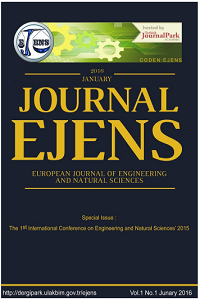Indoor Particle Size Distribution and Ionic Content of Particles in the Laboratory of ISTAC Composting Facility
Indoor Particle Size Distribution and Ionic Content of Particles in the Laboratory of ISTAC Composting Facility
Particle size distribution, ionic content active sampling,
___
- K. T. Whitby, W. E. Clark, V.A. Marple, G.M. Sverdrup, G. J. Sem, K. Willeke, B. Y. H. Liu, D.Y.H. Pui, " Characterization of California aerosols—I. Size distributions of freeway aerosol", Atmos Environ., vol. 9, pp. 463–482, 1975
- L. Morawska, S. Thomas, M. Jamriska, G. Johnson, "The modality of particle size distributions of environmental aerosols", Atmos Environ, vol. 33, pp. 4401–4411, 1999
- J. H. Seinfeld and S. N. Pandis, Atmospheric Chemistry and Physics: from air pollution to climate change, 2nd ed., Berlin, USA: Wiley, 2006.
- S. L. Kuzu, A. Saral, S. Demir, G. Summak, G. Demir, "A detailed investigation of ambient aerosol compositions and size distribution in an urban atmosphere", Environ Sci Pol Res, vol. 20, pp. 2556-2568, 2013
- Ü. Alver Şahin, K. Scherbakova, B. Onat, "Size distribution and seasonal variation of airborne particulate matter in five areas in Istanbul, Turkey", Environ Sci Pol Res, vol. 19, pp. 1198-1209, 2012
- B. Onat, Ü. Alver Şahin, C. Bayat, "Assessment of particulate matter in the urban atmosphere: size distribıtion, metal composition and source characterization using principal component analysis", J. Environ Mon., vol.14, pp. 1400-1409, 2012
- Başlangıç: 2015
- Yayıncı: CNR Çevre
PSIM Simulation of Flyback Converter for P&O and IC MPPT Algorithms
Chemically Color Removal from Textile Wastewater with Oxidizing and Reducing Agents
Mustafa KARABOYACI, Mesut UYSAL, Aziz ŞENCAN, Mehmet KILIÇ
Determination of Priority Contamination Factors in Lake of Manyas (Bird Paradise)
Enhancing Heat Transfer from a Porous Plate with Transpiration Cooling
Effect of High Dosage Air-Entraining Admixture Usage on Micro Concrete Properties
Isotherm and Kinetic Modelling of Azo Dyes Adsorption
